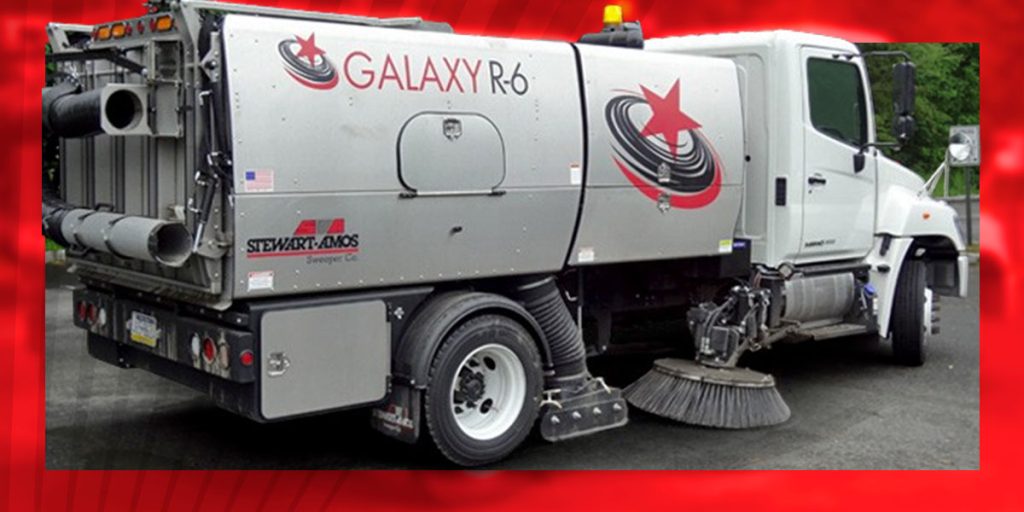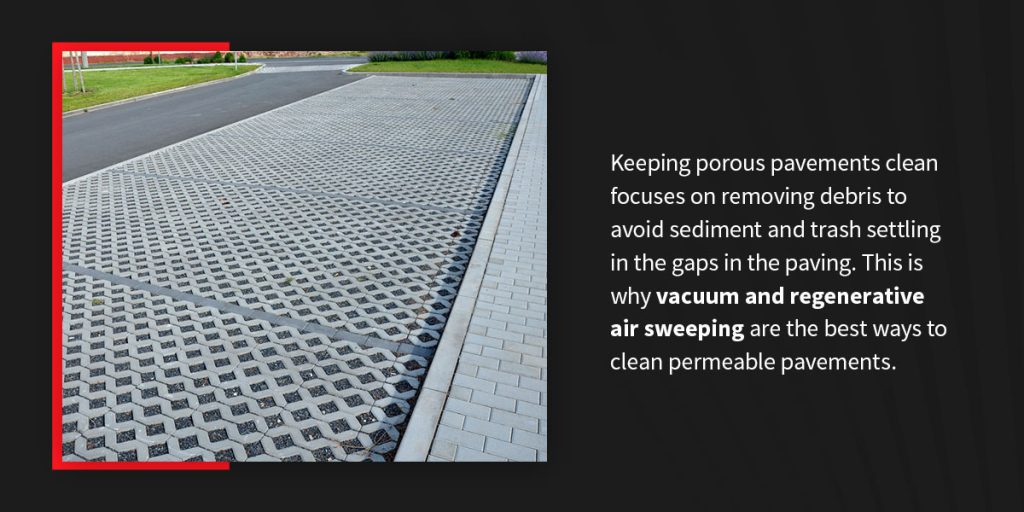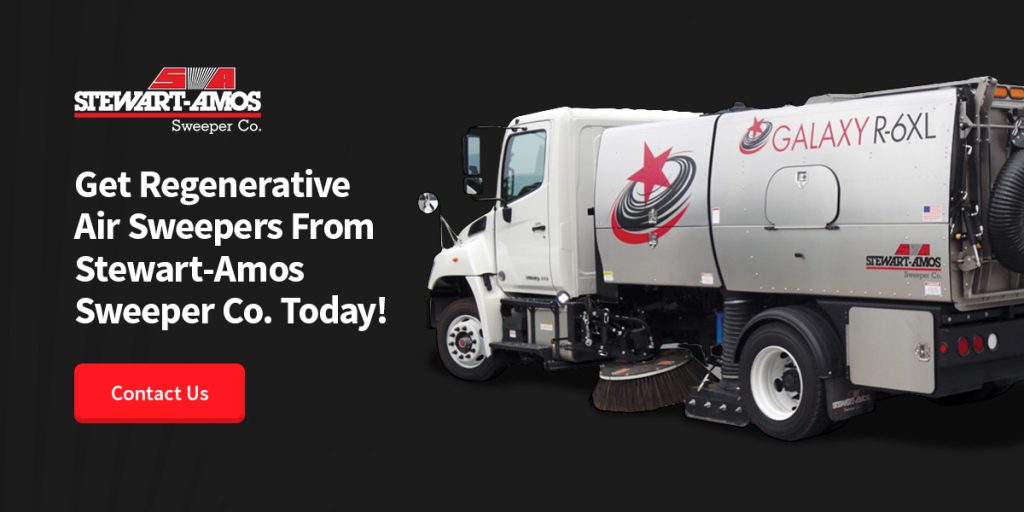Paving is an essential part of infrastructure across communities and cities worldwide. Porous pavement is present in many cities due to its versatility and longevity. Permeable paving allows water to reach the subsoil and enter groundwater systems safely. As a result, it is often used to help limit the effects of flooding.
However, the exact porous nature of permeable paving means it needs to be cleaned differently from traditional paving. Sweeping porous pavement, especially interlocking pavers, can lead to debris building up in the spaces intended for water travel. The most effective way to clean permeable pavement is by using regenerative air and pure vacuum sweepers rather than the typical mechanical street sweepers. They both ensure debris is removed rather than causing blockages.

What Is Porous Pavement?
Porous and permeable pavement are paving types that allow water to pass through and reach the soil beneath them. They are made from materials with numerous air voids and empty spaces through which water can move. At the same time, the materials are sturdy enough to carry the weight of pedestrians and vehicles.
To work correctly, porous pavement must be laid over a substrate, typically a stone bed, that stores the water before it filters into the soil. The substrate also helps prevent the water level in the soil from rising and reaching the pavement.
There are a few types of permeable paving, including interlocking pavers, porous asphalt, fake “grass” and porous concrete. The paving used will depend on the location, application and construction budget. Permeable paving is commonly used in urban, industrial and suburban applications, including parking lots, driveways, walkways and outside entertainment areas.
Porous pavement is mainly used to manage excess water run-off from storms as the water can reach the subsoil instead of settling on the pavement surface. Other benefits of porous pavement include the following:
- Fills groundwater systems: Instead of water running into drainage systems, water can soak into the subsoil and replenish groundwater systems.
- Improves water quality: As water filters through the pavement material and subsoil, it is subjected to natural cleansing processes that can remove pollutants, sediment and contaminants.
- Enhances landscapes: Interlocking and “grass” pavers can help create beautiful and aesthetically pleasing landscapes.

Porous Pavement Sweeping Best Practices
Porous pavement is different from traditional pavement empty or open spaces are deliberately incorporated into its design. Cleaning needs to consider these spaces. If too much debris builds up in these spaces, it can block the water pathways, causing it to settle on the surface. Excess water may then settle on the pavement’s surface, leading to flooding and other water damage.
Keeping porous pavements clean focuses on removing debris to avoid sediment and trash settling in the gaps in the paving. This is why vacuum and regenerative air sweeping are the best ways to clean permeable pavements. Each type of sweeper is essential to cleaning and maintaining porous pavements. Their use will depend on how much debris needs to be cleared. The frequency can increase depending on the intensity and frequency of storms, how much debris is deposited on the pavement and pedestrian and vehicle traffic in the area.
Avoid using de-icer and sand on permeable pavement during winter, as the fine particles have a higher chance of infiltrating into the empty spaces, clogging them. If sand or de-icer is required for the safety of pedestrians and drivers, porous pavements should be swept as soon as possible to prevent clogging.
Inspection
The first step in keeping porous pavement clean is inspecting it. New permeable paving needs to be checked regularly within the first few months after installation for any visible issues, including shifting pavers or cracking asphalt. After that, porous pavements must be inspected annually to check for damage and clogging. It is best to evaluate the condition of permeable paving after a big storm or heavy snowfall, as the additional water runoff can carry extra sediment and debris into the spaces.
Knowing the condition of the pavement will help you decide how often to sweep the pavement and what type of sweeper to use.
Vacuum Sweeping
Pure vacuum sweepers are essential to keeping porous pavements clean and unclogged. They are powerful vacuums modified to work outside and clean streets and pavements. Vacuum sweepers remove any debris by pulling it into the sweeper and depositing it into a hopper. The air pulled in is then released via the exhaust. Water sprayed into the hopper or from the side brooms ensures no fine dust particles are released back into the air.
A pure vacuum sweeper can remove a wide range of materials from porous paving, including sand, small stones, ground-up organic matter and other fine debris. Permeable pavements should be cleaned with a pure vacuum sweeper at the end of every season at a minimum. This ensures any stubborn debris is removed.
Pure vacuum sweepers are also ideal for permeable surfaces that have not been cleaned or maintained for a while. Several passes with a pure vacuum sweeper can help pull out embedded debris and free up any clogs.
Regenerative Air Sweepers
Regenerative air sweepers use carefully controlled blasts of air to dislodge debris from surfaces. They then vacuum up the debris and place it in the hopper. They constantly circulate air internally, using vacuumed air in future blasts. The vacuuming strength of a regenerative air sweeper is slightly lower than a pure vacuum sweeper, making it ideal for more regular vacuuming of permeable pavements. Like with pure vacuum sweepers, water is sprayed on the debris in the hopper or on side brooms to limit dust.
The vacuuming power of regenerative air sweepers means they are well-suited for monthly or weekly sweeping. They are also well suited to porous pavements with stones or rocks between pavers. Careful air blasts can remove debris trapped between the rocks. At the same time, the vacuum is powerful enough to remove debris such as trash, organic matter and sand without disturbing the heavier stones.

Get Regenerative Air Sweepers From Stewart-Amos Sweeper Co. Today!
The use of a regenerative air sweeper for cleaning permeable pavements is essential. They ensure debris is removed correctly without clogging. They are versatile and can be used in various applications, including cleaning parking lots and streets. Our team will help you find the perfect sweeper for your street-sweeping needs.
We offer both high-quality new and pre-owned models. Browse through our range of regenerative air sweepers today. Or speak to one of our experts about renting or buying a street sweeper now!
